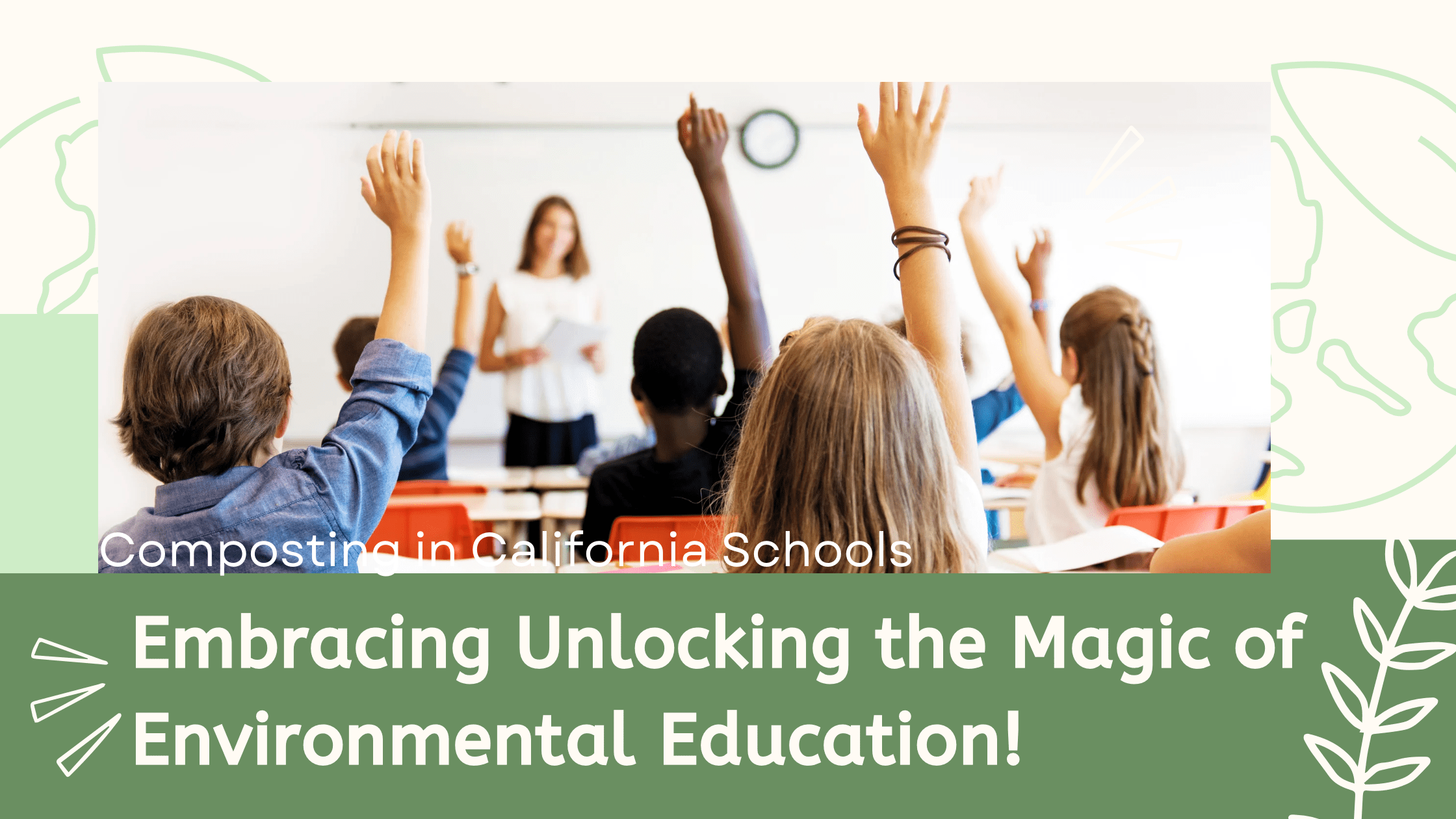
Embracing Unlocking the Magic of Environmental Education!
Did you know composting is not only a sustainable way to manage waste, but it also has the potential to unlock the magic of environmental education in California schools? Introducing composting programs to students will have a significant impact on their understanding of recycling, reducing food waste, and the importance of nurturing the soil. This hands-on approach not only educates them about sustainable practices but also empowers them to make a positive difference in the world. By instilling these values at an early age, we are fostering a generation that is equipped with the knowledge and motivation to create a brighter and more sustainable future for all. Join us as we dive into the world of composting in California schools and discover the magic it holds for our environment and our children.
The Power of Composting in California Schools
Why start a composting project at your school? The main reason is that composting has the power to transform the way California schools approach waste management and environmental education. By implementing composting programs, schools can harness the power of organic waste to create rich, nutrient-dense compost that can be used to nourish the soil and reduce the need for harmful chemical fertilizers and watering. This article will explore the various benefits of composting in California schools.
Transforming Waste into Gold: How Composting Works
What is composting? Composting is a natural process that transforms organic waste into nutrient-rich soil, often called “black gold” due to its enhanced ability to nourish the soil and support plant growth.
Composting provides an incredible educational opportunity for students. They can delve into the science behind decomposition and learn about how microorganisms play a vital role in nutrient cycling. By actively participating in the process of composting, students gain a deeper understanding of important topics such as sustainability, resource conservation, and how ecosystems are interconnected. It’s an exciting way to foster curiosity and inspire future environmental stewards within your school community. Let’s discuss how we can successfully implement composting programs in California schools. We will cover what can be composted, the optimal conditions for compost piles, and applications for the finished product.
First, we will cover what can be composted. The short answer is organic matter, like food scraps, plant materials, and yard trimmings. It is important to avoid including meat, dairy products, or oily items in your compost pile as they can attract pests or slow down the decomposition process and create a foul odor. Next, let’s consider the requirements for optimal decomposition. Microorganisms such as bacteria, fungi, and insects play a vital role in breaking down organic matter into simpler compounds. Three key ingredients needed to ensure their thriving presence are oxygen, moisture, and a balanced carbon-to-nitrogen ratio. A healthy decomposition process requires an ideal carbon-to-nitrogen ratio of approximately 30:1. Maintaining an appropriate balance of carbon and nitrogen is essential for successful composting. Carbon-rich materials such as dried leaves and wood chips provide energy for the microorganisms while nitrogen-rich materials like grass clippings and vegetable scraps supply essential nutrients.
To begin a compost pile, follow these five easy steps:
1. Collect organic waste and educate on what can be composted.
2. Layer “browns” (dried leaves) and “greens” (fruit/veggie scraps).
3. Turn the pile to aerate and mix materials.
4. Keep the pile moist but not too wet.
5. Monitor temperature to ensure proper decomposition.
You know the compost has turned to soil once it is a rich, crumbly texture and transformed from its original form. Allowing the compost to cure even further before use enhances the stability of the compost, reduces any lingering odors, and ensures that the nutrients are readily available for plants.
There are many benefits of finished compost, One great option is incorporating it into school gardens to enrich the soil promote healthy plant growth, and reduce the need for watering and pesticide use. It can also be used as a top dressing for lawns or mixed into potting soil for container plants. Utilizing finished compost in various landscaping projects throughout the campus not only creates beautiful outdoor spaces but also contributes to sustainability efforts.
By understanding the fundamentals of composting and implementing effective composting programs, California schools can contribute to waste reduction, foster environmental awareness, and empower students to become active stewards of the environment. By transforming organic matter into “black gold,” schools can unlock the magic of environmental education and create a greener future for California.
Spreading the Green Revolution: Investing in Composting Programs
Composting offers us the opportunity to have a significant impact on the environment and foster sustainability on a larger scale. In addition to reducing waste in landfills, composting also provides valuable educational opportunities for students. When students actively participate in the composting process, they learn to be responsible stewards of their environment and take ownership of their actions.
Implementing comprehensive composting programs can create a positive chain reaction as students share their newfound knowledge and passion for sustainability with their families and communities. This ripple effect has the potential to inspire more individuals to adopt eco-friendly practices and lay the foundation for a brighter and greener future that will be cherished and enjoyed by generations to come.
Let’s join forces and fully invest in these impactful composting programs, setting the stage for a sustainable future that we can all be proud of.
Empowering the Next Generation: Teaching Responsibility through Composting
These programs not only contribute to environmental sustainability but also provide an excellent opportunity to teach students about responsibility and the importance of taking care of the planet. By involving students, schools can empower the next generation to become active participants in creating a more sustainable future. Here are some ways composting can be used as a tool to teach responsibility:
- When students participate, they gain a deeper understanding of how their actions impact the environment. They learn how composting reduces greenhouse gas emissions from landfills and promotes soil health. This knowledge empowers them to make informed choices and take responsibility for creating a more sustainable planet.
- Composting initiatives foster collaboration and teamwork among students, teachers, and staff. Students work together towards a common goal, building a sense of community and shared responsibility. Student’s develop important interpersonal skills and discover the power of collective action in making positive changes.
- Composting challenges students to think critically and solve problems in real-world situations. They learn to troubleshoot issues like balancing carbon and nitrogen ratios, managing moisture levels, and maintaining proper airflow in compost bins. These problem-solving experiences enhance their critical thinking abilities, analytical skills, and creativity in finding innovative solutions.
- By participating, students become environmental stewards with a strong sense of responsibility toward the Earth’s future. They understand that they have a role in protecting the environment and preserving resources for generations to come. Taking ownership of composting makes them active advocates for sustainable practices not only within their schools but also within their communities.
- By incorporating environmental education into school curricula and activities, California schools can empower students to become responsible environmental citizens. Composting programs provide a platform for hands-on learning, waste reduction education, and collaboration, fostering a sense of environmental stewardship and empowering the next generation to make a positive impact on the planet.
Embracing the Future: Sustainability for a Greener California
Composting programs provide an invaluable platform for hands-on learning experiences, fostering community engagement opportunities, and nurturing a sustainable mindset among students. Through instilling a sense of responsibility towards our ecosystem early on, schools play a pivotal role in shaping a greener and more sustainable California that will serve as a lasting legacy for generations yet to come. By integrating composting into their curriculum and activities, California schools have the power to contribute significantly towards a more eco-friendly and sustainable state. Here are some key ways in which composting can help pave the way for a brighter future of sustainability in California:
Schools holds the potential to combat climate change by reducing methane emissions and diverting organic waste away from landfills. Students can gain valuable knowledge about waste management, composting techniques, and overall sustainability while also utilizing the resulting compost in school gardens and landscaping projects. Moreover, incorporating composting into school practices promotes water conservation efforts, fosters a circular economy mindset, and encourages community engagement. By educating students about the benefits of composting, schools can shape environmentally conscious leaders who will go on to make positive contributions within their communities and beyond.
Conclusion: Unlocking the Magic of Environmental Education through Composting in California Schools
Through composting, students gain a hands-on understanding of the impact their actions have on the world around them. They learn about the connections between waste management, soil health, and biodiversity, and develop a deep appreciation for the natural systems that sustain us. Composting programs offer a unique opportunity for students to engage with their communities and make a real-world impact.
By incorporating composting into the curriculum, schools can create a culture of sustainability and environmental responsibility. Students learn about ecological processes, sustainable practices, and waste management, equipping them with the tools they need to become informed and engaged citizens. These programs provide a foundation for lifelong sustainability practices, ensuring that California’s future is greener and more sustainable for future generations.
Overall, California schools have a tremendous opportunity to make a difference through composting programs. By embracing this sustainable approach to waste management, students can become powerful advocates for the environment. Composting initiatives offer a range of benefits, from mitigating climate change to conserving water to fostering a circular economy.
